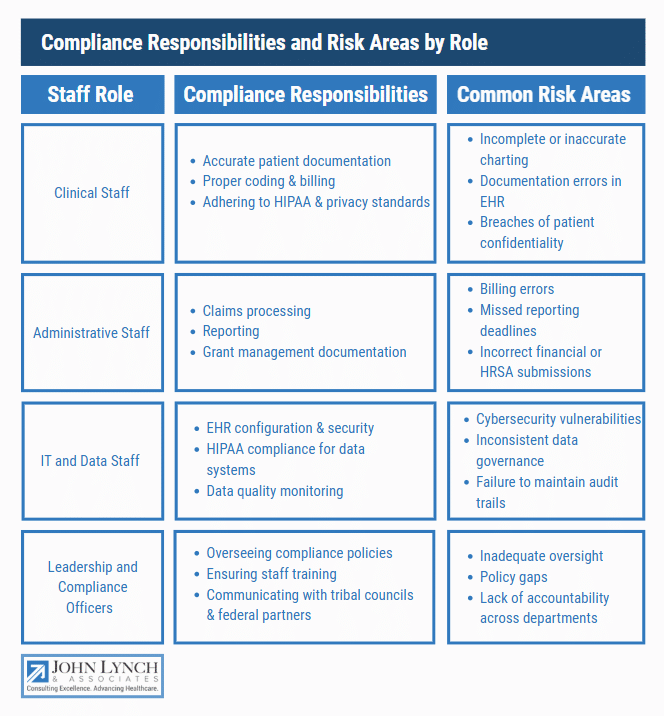Article Highlights
- Tailored staff compliance training reduces documentation errors, audit findings, and regulatory risks.
- Training supports sovereignty, accountability, and cultural trust within tribal communities.
- Proactive investment in workforce development protects funding and builds long-term sustainability.
- 1. Article Highlights
- 2. Building Awareness of Compliance Challenges in Tribal Healthcare
- 3. Staff Compliance Training as a Strategic Investment
- 4. Why Tailored Compliance Training Matters for Every Role
- 5. Improving Audit Outcomes Through Training
- 6. Strengthening Community Trust Through Compliance in Tribal Health
- 7. How John Lynch & Associates Supports Tribal Health Training Initiatives
- 8. Action Steps for Tribal Health Leaders
- 9. Conclusion: Leading Tribal Health with Confidence and Compliance
- 10. Ready to Talk?
- 11. Further Reading
- 12. Related Articles
Building Awareness of Compliance Challenges in Tribal Healthcare
Tribal health organizations face a unique and complex compliance landscape. In addition to federal requirements from agencies like the Centers for Medicare & Medicaid Services (CMS), the Health Resources and Services Administration (HRSA), and the Department of Health and Human Services (HHS), these organizations must also meet Indian Health Service (IHS)-specific regulations and, in some cases, state-level mandates. This overlapping web of requirements creates significant regulatory risk in tribal health operations. Understanding how compliance intersects with technology and governance is vital, see our insight on Strategic IT Planning for Tribal Health Leaders
For many clinics, the most common compliance challenges stem from documentation errors, gaps in reporting, and vulnerabilities in data privacy. A single incomplete record, a missed Uniform Data System (UDS) deadline, or a breach in HIPAA standards can result in penalties, funding setbacks, and a loss of community trust. Tribal health systems in rural or resource-limited settings face added challenges, as staff often juggle multiple responsibilities and may not have consistent access to compliance training.
Unlike larger health systems, tribal clinics are especially vulnerable because compliance responsibilities are often concentrated on a few individuals. When staff lack the proper training or workflows are not standardized, the risk of mistakes grows. From EHR documentation by frontline staff to claims processing by administrators and policy oversight by leadership, each action contributes to overall compliance. Building awareness of these challenges is the first step toward reducing risk and creating a culture where compliance is viewed as a shared responsibility.
Staff Compliance Training as a Strategic Investment
Moving Beyond “Check-the-Box” Training
Too often, compliance training in healthcare is treated as a routine task to satisfy regulatory requirements. Staff are asked to complete annual modules or sit through brief sessions, but little attention is given to whether the training is practical, relevant, or role specific. This “check-the-box” approach may create the appearance of compliance but leaves real risks unaddressed. In tribal health organizations, where resources are limited and staff carry multiple responsibilities, this kind of training is not enough to protect the clinic or its patients.
The True Cost of Non-Compliance
Non-compliance is far more costly than most leaders realize. Financial penalties, audit findings, and the potential loss of federal funding can have devastating effects on tribal health programs. Beyond financial consequences, lapses in compliance can erode trust with patients, tribal councils, and community stakeholders. By comparison, the investment in structured, ongoing staff compliance training is minimal. Training equips staff with the tools to avoid costly errors, ensuring resources remain available to expand and strengthen care.
Calculating the Return on Investment
The return on investment (ROI) for compliance training is both measurable and meaningful. For example, if tailored staff training prevents just one major audit finding, the savings from avoided penalties or funding setbacks can far exceed the cost of training. More importantly, well-prepared staff contribute to smoother audits, higher-quality reporting, and stronger alignment with IHS and HRSA expectations. Leaders who view training as an investment rather than an expense set their organizations on a path toward long-term sustainability.
Why Leaders Must Champion Training
Successful training programs depend on tribal health leaders who actively support and model their value. When leadership prioritizes compliance, it becomes understood as an organizational standard rather than just a regulatory obligation. When staff see that leaders prioritize training, they are more likely to engage fully and carry that knowledge into daily practice. This leadership-driven approach strengthens accountability, supports sovereignty, and builds a culture of resilience across the workforce.

Why Tailored Compliance Training Matters for Every Role
One Size Does Not Fit All
Compliance training is most effective when it recognizes that different roles carry different responsibilities and risks. A single, generic training session cannot prepare every member of the workforce to handle the unique compliance challenges they face. Tailored training ensures staff at all levels, from frontline clinicians to administrative teams and leadership, are equipped with the knowledge and tools they need to perform their roles with confidence and accuracy.
Clinical and Frontline Staff
Frontline staff often have the greatest impact on compliance because they are responsible for patient documentation, coding, billing, and adhering to HIPAA and privacy standards. A missed entry or inaccurate chart can trigger major audit concerns and compromise patient care. Training these team members to document effectively in the EHR, follow billing protocols, and safeguard patient confidentiality is essential to reducing risk.
Administrative Staff
Administrative staff are central to the financial and regulatory health of tribal clinics. Their responsibilities span; claims processing, program reporting, and grant documentation, and even minor mistakes in these areas can create significant setbacks. A delayed submission or inaccurate HRSA report can threaten funding streams, making it essential that training for these roles focus on precision, consistency, and an up-to-date understanding of evolving requirements.
IT and Data Staff
As healthcare grows increasingly digital, IT and data staff play a critical role in compliance. Their responsibilities include EHR configuration, HIPAA compliance for data systems, and ongoing monitoring of data quality. Without proper training, these staff may leave systems vulnerable to cybersecurity threats, inconsistent data governance, or failed audit trails. Training should equip them with both technical skills and a strong understanding of healthcare-specific compliance standards.
Leadership and Compliance Officers
Leadership sets the tone for compliance across the organization. Leaders and compliance officers are responsible for policy oversight, staff education, and communication with tribal councils and federal partners. Without clear accountability and visibility, compliance efforts can stall. Training for leadership should emphasize strategic oversight, risk awareness, and effective communication to ensure policies are not only established but consistently followed.

Improving Audit Outcomes Through Training
What Auditors Look For
When surveyors or auditors review a tribal health organization, they are not only checking policies on paper. They look closely at whether staff understand compliance expectations and can put them into practice. This means frontline staff need to demonstrate accurate documentation in the electronic health record (EHR), administrative teams must show consistency in HRSA Uniform Data System (UDS) reporting, and leadership must provide evidence of clear oversight. An audit is as much about staff readiness as it is about organizational systems.
Reducing Errors Through Training
Well-designed training directly reduces the types of errors that most often lead to negative audit findings. Inconsistent charting, missed deadlines, and incomplete financial records can be traced back to gaps in staff knowledge or confidence. By ensuring training is regular, practical, and role-specific, organizations create staff who are both competent and confident in their responsibilities. This preparation results in fewer mistakes, stronger documentation, and a smoother audit process.
Four Steps to Strengthen Audit Readiness Through Training
- Assess Staff Knowledge Gaps – Begin with a compliance gap analysis to identify where staff lack confidence or understanding.
- Provide Role-Specific Training – Deliver tailored sessions for clinical, administrative, IT, and leadership staff based on their compliance responsibilities. Explore our Regulatory Compliance Services to see how this support can be designed for your organization.
- Conduct Mock Audits – Simulate real audit conditions so staff can practice documentation, reporting, and responding to auditor questions.
- Reinforce through refreshers. Schedule ongoing training and updates to ensure staff remain current with Indian Health Service policies, HRSA requirements, and CMS changes.
A Case in Point
The Role of Ongoing Practice
Compliance is not a one-time exercise. Staff benefit from repeated opportunities to reinforce knowledge through mock audits, scenario-based training, and refresher aligned with new regulations. These efforts build confidence, prepare teams for real world scrutiny, and position the organization as audit ready year-round rather than scrambling at the last minute. For additional guidance, visit our Tribal Health Consulting solutions page.

Strengthening Community Trust Through Compliance in Tribal Health
Why Trust Matters in Compliance
For tribal health organizations, compliance is about much more than satisfying federal regulations. It is also about earning and maintaining the trust of patients, families, tribal councils, and community leaders. When staff demonstrate consistent compliance practices, they send a message of accountability and professionalism that strengthens confidence in the care being provided.
Compliance Training as a Foundation for Trust
Staff compliance training helps build this trust by ensuring that every employee, from clinicians to administrators, understands their responsibilities. Patients feel safer knowing their privacy is protected under HIPAA guidelines. Tribal councils and governing boards see evidence of integrity in how resources are managed and reported. Federal partners such as HRSA and CMS gain confidence that funding is being used responsibly. Together, these outcomes reinforce credibility at every level.
How Trained Staff Build Confidence
Well-trained staff demonstrate competence in ways that are visible to the community and regulators alike. For example:
- Patients and Families: Confident staff interactions and accurate record-keeping assure patients that their care is both safe and confidential.
- Tribal Councils and Leaders: Clear and accurate reporting builds trust that resources are being used responsibly and programs are meeting expectations.
- Federal and State Partners: Compliance with IHS and HRSA requirements strengthens relationships with funders and increases opportunities for future support.
Three Steps to Build Trust Through Training
- Make Training Routine and Visible. Demonstrating a commitment to regular compliance education shows both staff and the community that accountability is a priority.
- Connect Training to Values. Frame compliance training as a way to protect sovereignty, respect cultural priorities, and safeguard community health.
- Celebrate Compliance Successes. Share positive audit results or staff achievements with tribal councils and community stakeholders to highlight the impact of training.
Why Consistency Matters
Trust is not built in a single training session. It is developed over time, through consistent education and reinforcement. When compliance becomes a shared value, staff morale improves, turnover decreases, and communities see the organization as a reliable, accountable partner in care delivery. For organizations looking to strengthen both compliance and trust, investing in workforce development through structured training is one of the most effective strategies.
For tailored approaches to strengthening workforce culture and compliance, explore our Tribal Health Consulting services.
How John Lynch & Associates Supports Tribal Health Training Initiatives
Comprehensive Training Programs for Every Role
Supporting tribal health organizations requires more than delivering generic training modules. We partner with leaders to design programs that address the specific compliance responsibilities of frontline staff, administrative teams, IT and data staff, and leadership. Our Regulatory Compliance services provide structured role-based training that helps staff understand not only what is required of them, but also why compliance is critical to sustaining funding and community trust.
Tailored to Tribal Governance and Culture
The structure of each tribal health system is influenced by its governance, local priorities, and cultural heritage. We design training that respects sovereignty while meeting the expectations of Indian Health Service (IHS), HRSA, and CMS. This ensures that compliance is not just an external obligation but is also aligned with the unique identity and goals of the community.
Leadership Coaching and Change Management
Compliance programs succeed when leaders set the tone. We provide leadership coaching that equips directors, compliance officers, and executives with strategies to communicate expectations, monitor accountability, and foster engagement. By embedding compliance in leadership practices, organizations create a culture that sees training as a strategic investment rather than a box-checking exercise.
Integration into Strategic Planning
Compliance training should not be separated from the organization’s overall strategy. We help clients integrate training into long-term planning, aligning it with workforce development, technology adoption, and clinical operations. Whether preparing for an audit, implementing a new EHR system, or pursuing clinic expansion, we ensure compliance training is embedded into the roadmap for growth.
What Sets Our Approach Apart
- Customized Solutions: No two tribal health systems are the same, and neither are their training needs.
- Hands-On Support: We go beyond workshops to provide mock audits, policy reviews, and scenario-based practice.
- Sustainability: We focus on building internal capacity so organizations can carry training forward with confidence
Action Steps for Tribal Health Leaders
Turning Awareness into Action
Understanding the value of compliance training is only the first step. Tribal health leaders must move from awareness to action by putting structures in place that make training consistent, meaningful, and sustainable. These steps help reduce compliance risk, prepare for audits, and reinforce trust across the community. Consider reviewing The Guide to Developing an EHR Optimization Strategy to ensure your training program evolves with your technology.
Five Key Actions to Strengthen Compliance Training
- Conduct a Training Gap Assessment: Begin with an honest evaluation of your organization’s current compliance readiness. Identify where staff lack knowledge or confidence in areas such as electronic health record (EHR) documentation, reporting, or HIPAA privacy. A structured gap assessment provides a clear baseline for improvement.
- Prioritize High-Risk Roles and Processes: Focus first on the staff and workflows that carry the greatest compliance risk, such as claims processing, UDS reporting, or patient privacy. Addressing these areas early prevents costly errors and sets a foundation for stronger audit outcomes.
- Schedule Regular Refresher Sessions: Compliance expectations evolve, and training should evolve with them. Establish a schedule of quarterly refreshers or scenario-based exercises so staff remain confident and prepared for regulatory changes.
- Integrate Accountability into Policies: Embed compliance responsibilities into job descriptions, performance evaluations, and organizational policies. When accountability is built into daily operations, training becomes part of the culture rather than an afterthought.
- Leverage External Expertise: Partner with consultants who understand the unique needs of tribal health systems. Expert support can help organizations design role-based training, conduct mock audits, and align compliance strategies with long-term goals.
Why Acting Now Matters
Delaying compliance training increases vulnerabilities and creates challenges that are harder to fix later. By taking proactive steps today, tribal health leaders protect their organizations, strengthen workforce confidence, and reinforce trust within the community.
Conclusion: Leading Tribal Health with Confidence and Compliance
Staff compliance training is more than a regulatory requirement. It is a leadership strategy that strengthens the foundation of tribal health organizations. By investing in tailored, role specific education, leaders reduce compliance risk, prepare their teams for audits, and build trust with patients, councils, and federal partners.
Proactive training also protects organizational sustainability. Knowledgeable staff reduce errors, streamline reporting, and demonstrate accountability, all of which safeguard vital funding and reinforce community confidence. Most importantly, a culture of compliance empowers the workforce to serve with integrity and confidence, ensuring tribal health systems remain strong for future generations.
Leaders who commit to compliance training today are not only avoiding risk. They are choosing to guide their organizations with resilience, sovereignty, and trust.
Ready to Talk?
Further Reading
- HIPAA Guidelines – U.S. Department of Health & Human Services: Federal standards for patient privacy and data security
- HRSA – Bureau of Primary Health Care: Information on Uniform Data System (UDS) reporting and compliance expectations
- Centers for Medicare & Medicaid Services (CMS): Regulations, Final Rules, and compliance updates impacting healthcare organizations
- Office of the National Coordinator for Health IT (ONC): Resources on EHR standards, interoperability, and compliance
- Regulatory Compliance Services: How we help healthcare organizations strengthen compliance and reduce risk
Related Articles

Reducing Risk in Tribal Health with Staff Compliance Training

A Comprehensive Tribal Health IT Strategy for Modern Tribal Health Leaders



